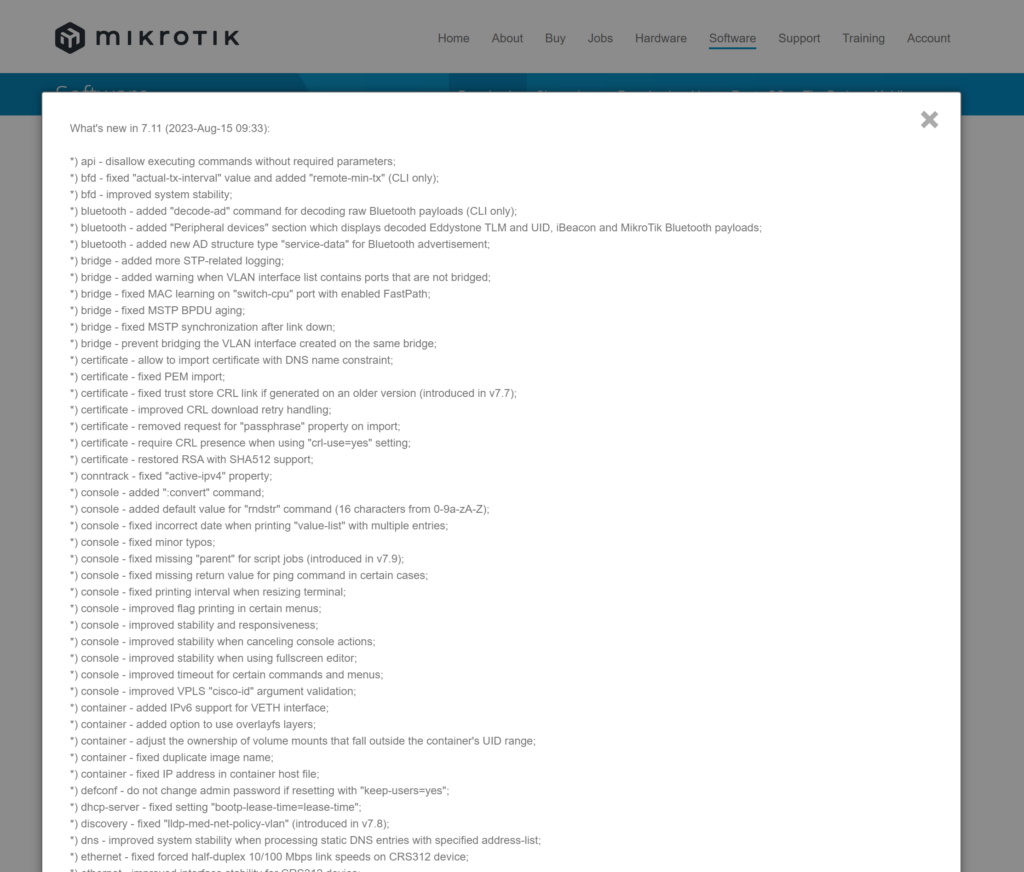2023 has been a big year for MikroTik RouterOS v7 development. The OS has matured quite a bit and the number of operators that are using ROSv7 in prod has gone up significantly.
Most of the work this year has been centered around feature parity with ROSv6 and performance improvements.
Although there have been a few new additions like the Back to Home VPN (Which is now scheduled to release with 7.12) and IS-IS (Also slated for 7.12).
This is important because most of the development time by MikroTik has been consumed by stabilization, feature parity and perf improvements. However, as that gap closes, we should see long awaited features like SR-MPLS and EVPN make it into ROS v7 faster as development time frees up.
7.11 contains a long list of fixes and improvements and will likely be adopted quickly by the MikroTik community.
MikroTik Routers and Wireless – Software

Noteworthy additions
bfd stability
*) bfd – fixed “actual-tx-interval” value and added “remote-min-tx” (CLI only);
*) bfd – improved system stability;
Bi-directional forwarding detection or BFD has been a feature gap in ROSv7 for a long time and was a showstopper for some ASNs that wanted to use the new CCR2K hardware as peering/border routers. Now that BFD has been implemented for BGP and OSPF with some stabilization fixes, it’s much easier to deploy a CCR2116 or CCR2216 in that role.
IPv6 support for containers
*) container – added IPv6 support for VETH interface;
Being able to use IPv6 for containers is a great addition given the rapid pace of IPv6 adoption in 2023. It also makes it easier to expose containers directly to the Internet without NAT if desired.
Continued improvement of l3hw offload
*) l3hw – changed minimal supported values for “neigh-discovery-interval” and “neigh-keepalive-interval” properties;
*) l3hw – fixed /32 and /128 route offloading after nexthop change;
*) l3hw – fixed incorrect source MAC usage for offloaded bonding interface;
*) l3hw – improved system responsiveness during partial offloading;
*) l3hw – improved system stability during IPv6 route offloading;
*) l3hw – improved system stability;
There were a number of l3hw fixes in 7.11 which allows the platforms with Marvell Prestera chips to be put into more roles for L3 switching and lower the cost of wirespeed performance for network operators.
Wifiwave2 development continues
*) wifiwave2 – added “steering” parameters and menu to set up and monitor AP neighbor groups (CLI only);
*) wifiwave2 – added more information on roaming candidates to BSS transition management requests (802.11v) and neighbor report responses (802.11k);
*) wifiwave2 – added option to filter frames captured by the sniffer command (CLI only);
*) wifiwave2 – automatically add wifi interfaces to appropriate bridge VLAN when wireless clients with new VLAN IDs connect;
*) wifiwave2 – changed default behavior for handling duplicate client MAC addresses, added settings for changing it (CLI only);
*) wifiwave2 – enabled PMK caching with EAP authentication types;
*) wifiwave2 – fixed “reg-info” information for several countries;
*) wifiwave2 – fixed “security.sae-max-failure” rate not limiting authentications correctly in some cases;
*) wifiwave2 – fixed clearing CAPsMAN Common Name when disabling “lock-to-caps-man”;
*) wifiwave2 – fixed interface hangs on IPQ6010-based boards (introduced in v7.9);
*) wifiwave2 – improved stability when changing interface settings;
*) wifiwave2 – improved stability when receiving malformed WPA3-PSK authentication frames;
*) wifiwave2 – make info log less verbose during client roaming (some info moved to wireless,debug log);
*) wifiwave2 – rename “reg-info” country argument from “Macedonia” to “North Macedonia”;
*) wifiwave2 – use correct status code when rejecting WPA3-PSK re-association;
The Wifiwave2 package has gotten a lot of love from the developers since the release of AX hardware and has stabilized quite a bit. The new wireless chips + active development might put MikroTik back in contention for wireless against WISP and WiFi vendors after a long period of limited innovation prior to the 2020s.

 +1 (855) 645-7684
+1 (855) 645-7684